SBI4U Biology Exam Solution: Cellular Processes, Genetics, and Systems
VerifiedAdded on 2022/12/26
|13
|1656
|78
Homework Assignment
AI Summary
This document provides a comprehensive solution to an SBI4U Biology exam, covering a range of topics including cellular processes, genetics, and homeostasis. The solution is divided into three parts: Part A consists of multiple-choice questions with answers; Part B compares and contrasts key biological processes like cellular respiration and photosynthesis, condensation and hydrolysis, transcription and translation, and positive and negative feedback mechanisms; Part C delves into detailed explanations of glycolysis, pyruvate oxidation, the Krebs cycle, and the electron transport chain, along with comparisons of interspecific and intraspecific competition and symbiotic relationships. The solution also covers topics such as the thylakoid membranes, the source of oxygen in photosynthesis, facilitated diffusion, and the effects of mutations. The document also addresses the roles of the kidneys and hormones in maintaining homeostasis. References to scientific literature are included to support the answers provided.

Running Head: SBI4U
0
BIOLOGY
student
6/18/2019
0
BIOLOGY
student
6/18/2019
Paraphrase This Document
Need a fresh take? Get an instant paraphrase of this document with our AI Paraphraser
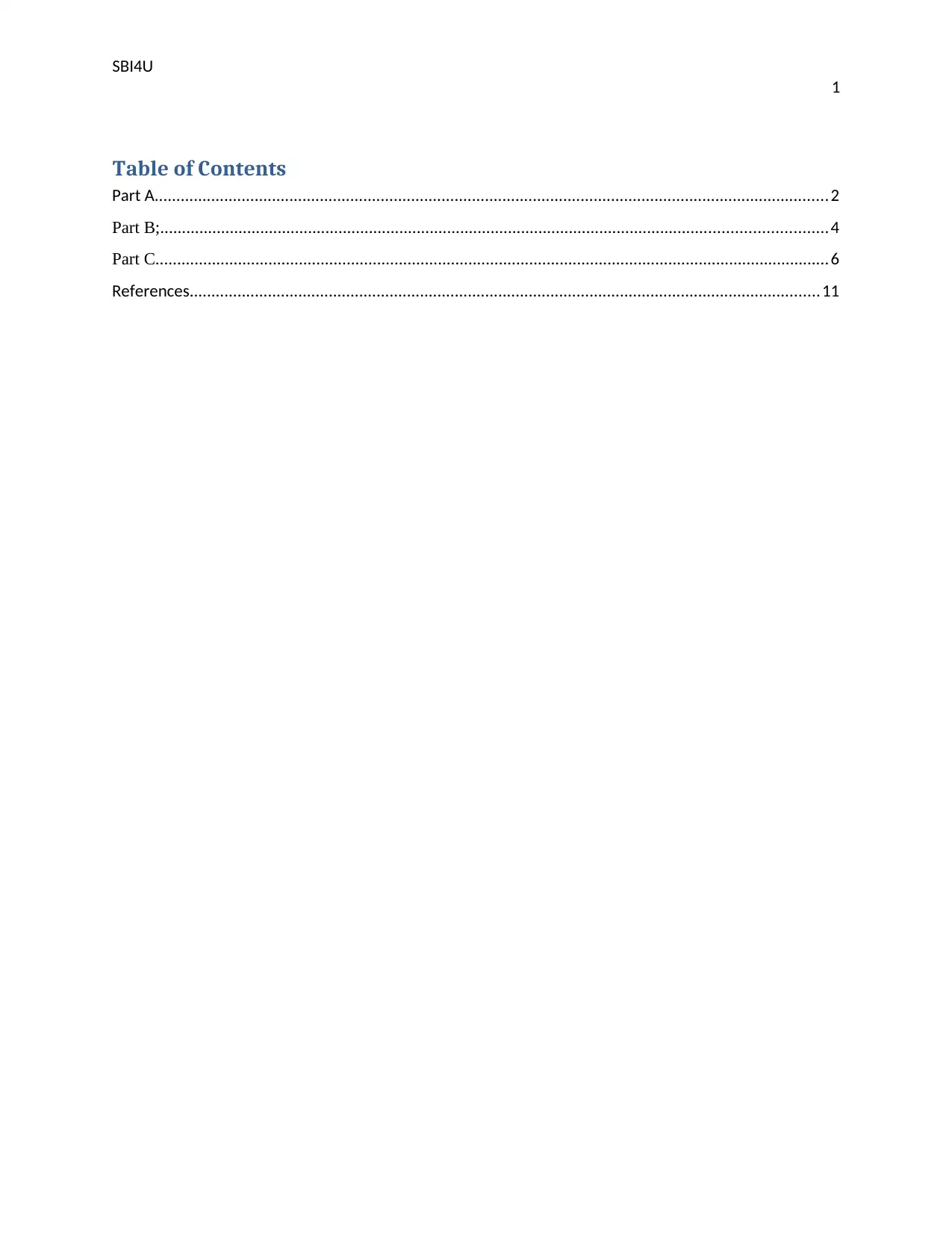
SBI4U
1
Table of Contents
Part A...........................................................................................................................................................2
Part B;.........................................................................................................................................................4
Part C...........................................................................................................................................................6
References.................................................................................................................................................11
1
Table of Contents
Part A...........................................................................................................................................................2
Part B;.........................................................................................................................................................4
Part C...........................................................................................................................................................6
References.................................................................................................................................................11
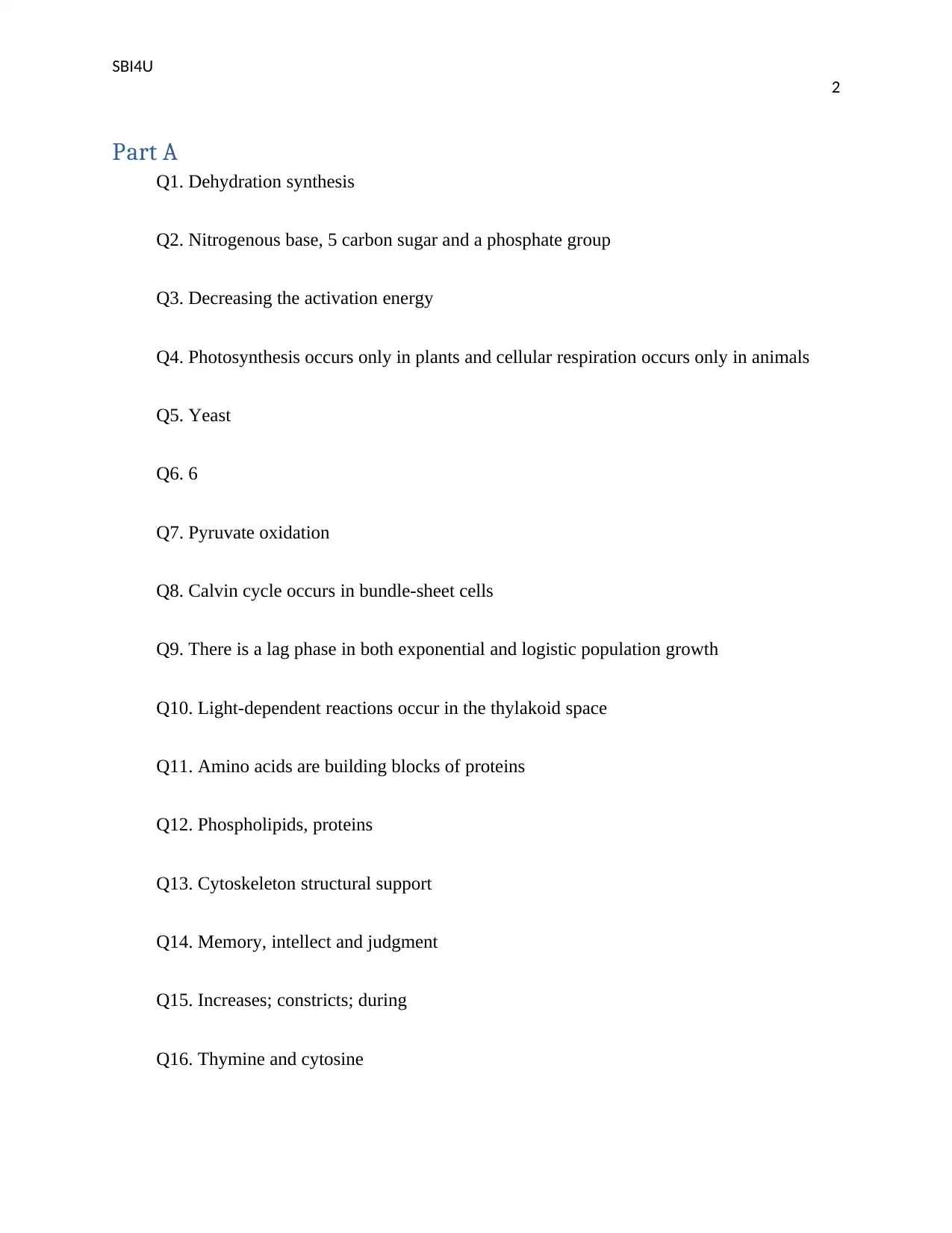
SBI4U
2
Part A
Q1. Dehydration synthesis
Q2. Nitrogenous base, 5 carbon sugar and a phosphate group
Q3. Decreasing the activation energy
Q4. Photosynthesis occurs only in plants and cellular respiration occurs only in animals
Q5. Yeast
Q6. 6
Q7. Pyruvate oxidation
Q8. Calvin cycle occurs in bundle-sheet cells
Q9. There is a lag phase in both exponential and logistic population growth
Q10. Light-dependent reactions occur in the thylakoid space
Q11. Amino acids are building blocks of proteins
Q12. Phospholipids, proteins
Q13. Cytoskeleton structural support
Q14. Memory, intellect and judgment
Q15. Increases; constricts; during
Q16. Thymine and cytosine
2
Part A
Q1. Dehydration synthesis
Q2. Nitrogenous base, 5 carbon sugar and a phosphate group
Q3. Decreasing the activation energy
Q4. Photosynthesis occurs only in plants and cellular respiration occurs only in animals
Q5. Yeast
Q6. 6
Q7. Pyruvate oxidation
Q8. Calvin cycle occurs in bundle-sheet cells
Q9. There is a lag phase in both exponential and logistic population growth
Q10. Light-dependent reactions occur in the thylakoid space
Q11. Amino acids are building blocks of proteins
Q12. Phospholipids, proteins
Q13. Cytoskeleton structural support
Q14. Memory, intellect and judgment
Q15. Increases; constricts; during
Q16. Thymine and cytosine
⊘ This is a preview!⊘
Do you want full access?
Subscribe today to unlock all pages.

Trusted by 1+ million students worldwide
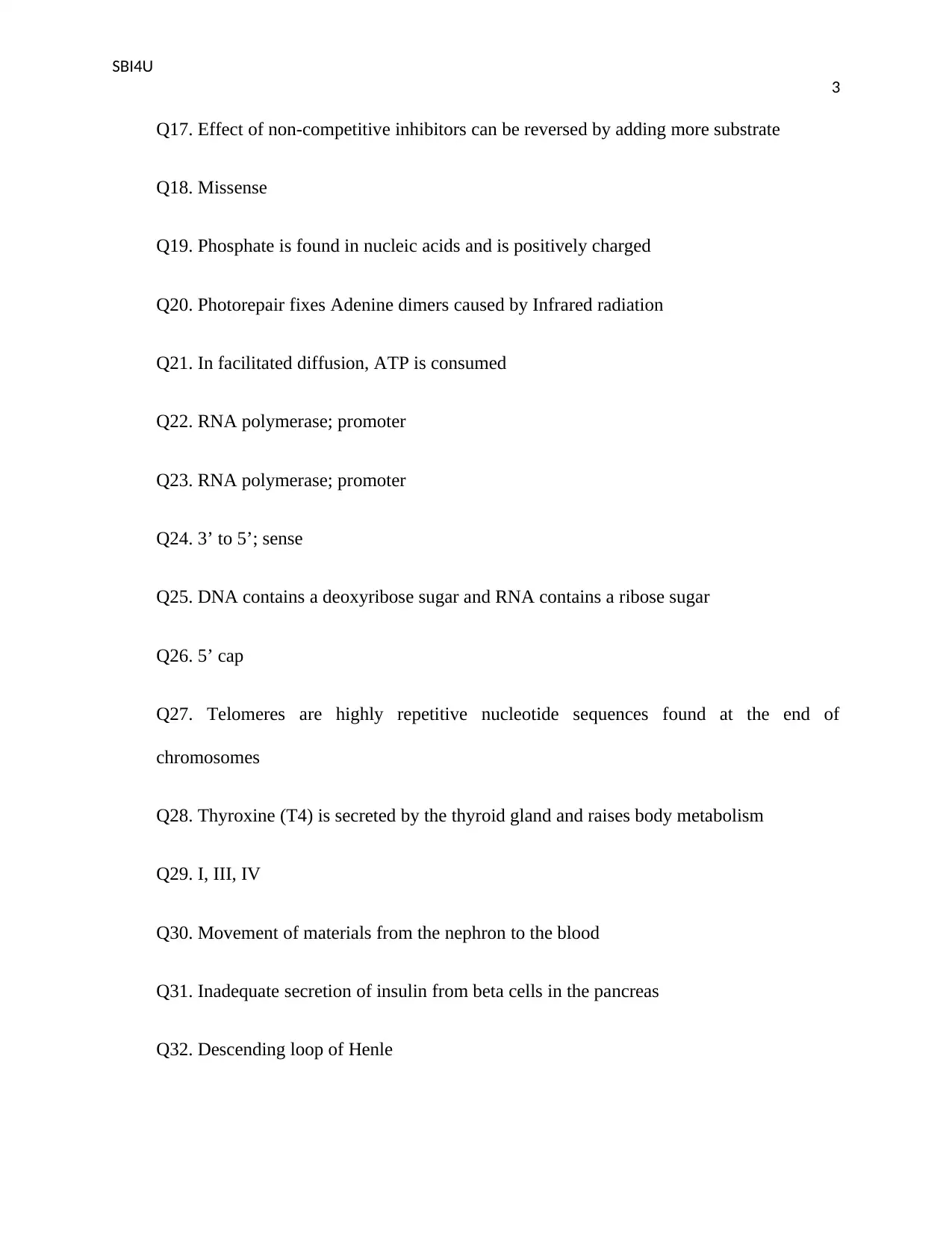
SBI4U
3
Q17. Effect of non-competitive inhibitors can be reversed by adding more substrate
Q18. Missense
Q19. Phosphate is found in nucleic acids and is positively charged
Q20. Photorepair fixes Adenine dimers caused by Infrared radiation
Q21. In facilitated diffusion, ATP is consumed
Q22. RNA polymerase; promoter
Q23. RNA polymerase; promoter
Q24. 3’ to 5’; sense
Q25. DNA contains a deoxyribose sugar and RNA contains a ribose sugar
Q26. 5’ cap
Q27. Telomeres are highly repetitive nucleotide sequences found at the end of
chromosomes
Q28. Thyroxine (T4) is secreted by the thyroid gland and raises body metabolism
Q29. I, III, IV
Q30. Movement of materials from the nephron to the blood
Q31. Inadequate secretion of insulin from beta cells in the pancreas
Q32. Descending loop of Henle
3
Q17. Effect of non-competitive inhibitors can be reversed by adding more substrate
Q18. Missense
Q19. Phosphate is found in nucleic acids and is positively charged
Q20. Photorepair fixes Adenine dimers caused by Infrared radiation
Q21. In facilitated diffusion, ATP is consumed
Q22. RNA polymerase; promoter
Q23. RNA polymerase; promoter
Q24. 3’ to 5’; sense
Q25. DNA contains a deoxyribose sugar and RNA contains a ribose sugar
Q26. 5’ cap
Q27. Telomeres are highly repetitive nucleotide sequences found at the end of
chromosomes
Q28. Thyroxine (T4) is secreted by the thyroid gland and raises body metabolism
Q29. I, III, IV
Q30. Movement of materials from the nephron to the blood
Q31. Inadequate secretion of insulin from beta cells in the pancreas
Q32. Descending loop of Henle
Paraphrase This Document
Need a fresh take? Get an instant paraphrase of this document with our AI Paraphraser
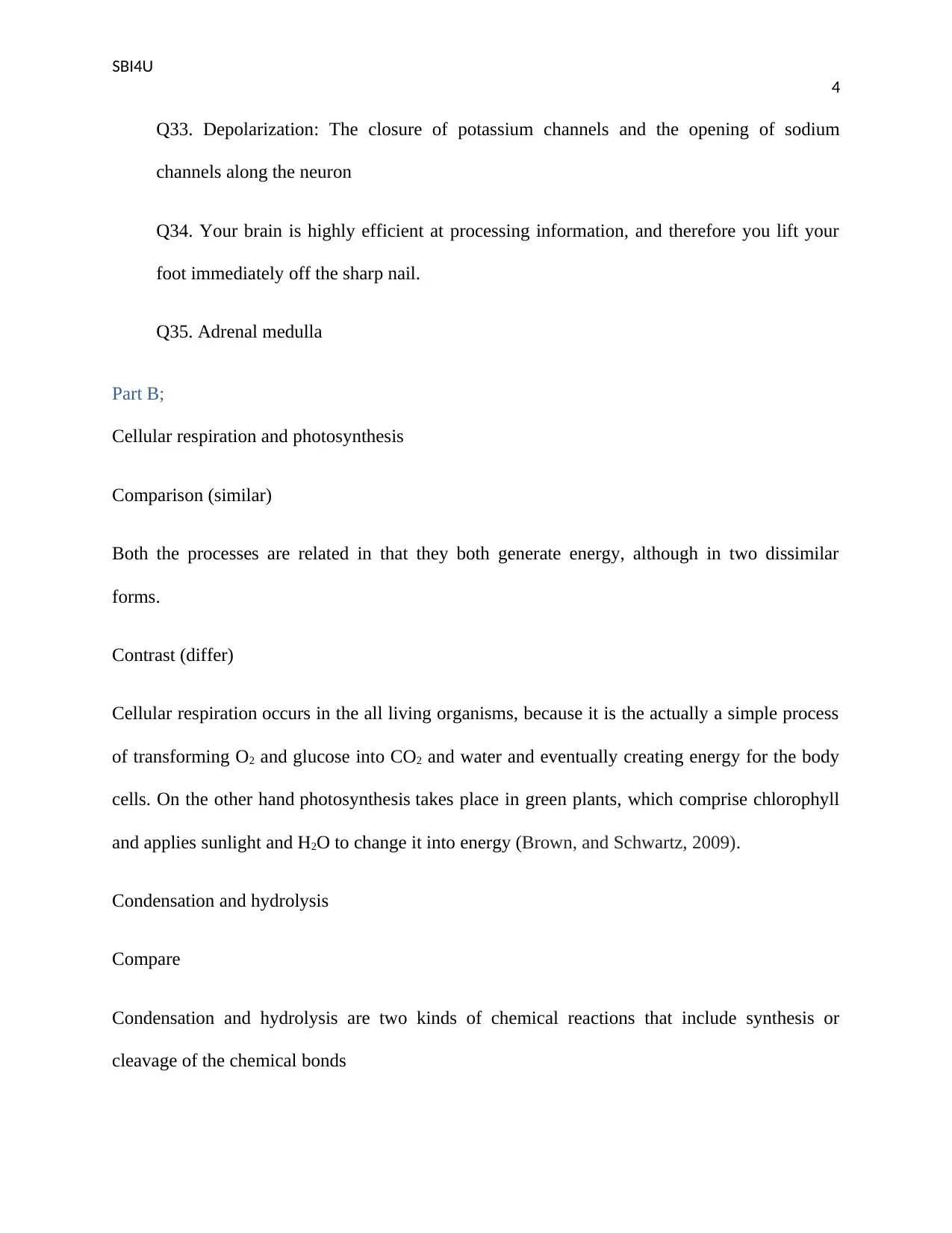
SBI4U
4
Q33. Depolarization: The closure of potassium channels and the opening of sodium
channels along the neuron
Q34. Your brain is highly efficient at processing information, and therefore you lift your
foot immediately off the sharp nail.
Q35. Adrenal medulla
Part B;
Cellular respiration and photosynthesis
Comparison (similar)
Both the processes are related in that they both generate energy, although in two dissimilar
forms.
Contrast (differ)
Cellular respiration occurs in the all living organisms, because it is the actually a simple process
of transforming O2 and glucose into CO2 and water and eventually creating energy for the body
cells. On the other hand photosynthesis takes place in green plants, which comprise chlorophyll
and applies sunlight and H2O to change it into energy (Brown, and Schwartz, 2009).
Condensation and hydrolysis
Compare
Condensation and hydrolysis are two kinds of chemical reactions that include synthesis or
cleavage of the chemical bonds
4
Q33. Depolarization: The closure of potassium channels and the opening of sodium
channels along the neuron
Q34. Your brain is highly efficient at processing information, and therefore you lift your
foot immediately off the sharp nail.
Q35. Adrenal medulla
Part B;
Cellular respiration and photosynthesis
Comparison (similar)
Both the processes are related in that they both generate energy, although in two dissimilar
forms.
Contrast (differ)
Cellular respiration occurs in the all living organisms, because it is the actually a simple process
of transforming O2 and glucose into CO2 and water and eventually creating energy for the body
cells. On the other hand photosynthesis takes place in green plants, which comprise chlorophyll
and applies sunlight and H2O to change it into energy (Brown, and Schwartz, 2009).
Condensation and hydrolysis
Compare
Condensation and hydrolysis are two kinds of chemical reactions that include synthesis or
cleavage of the chemical bonds
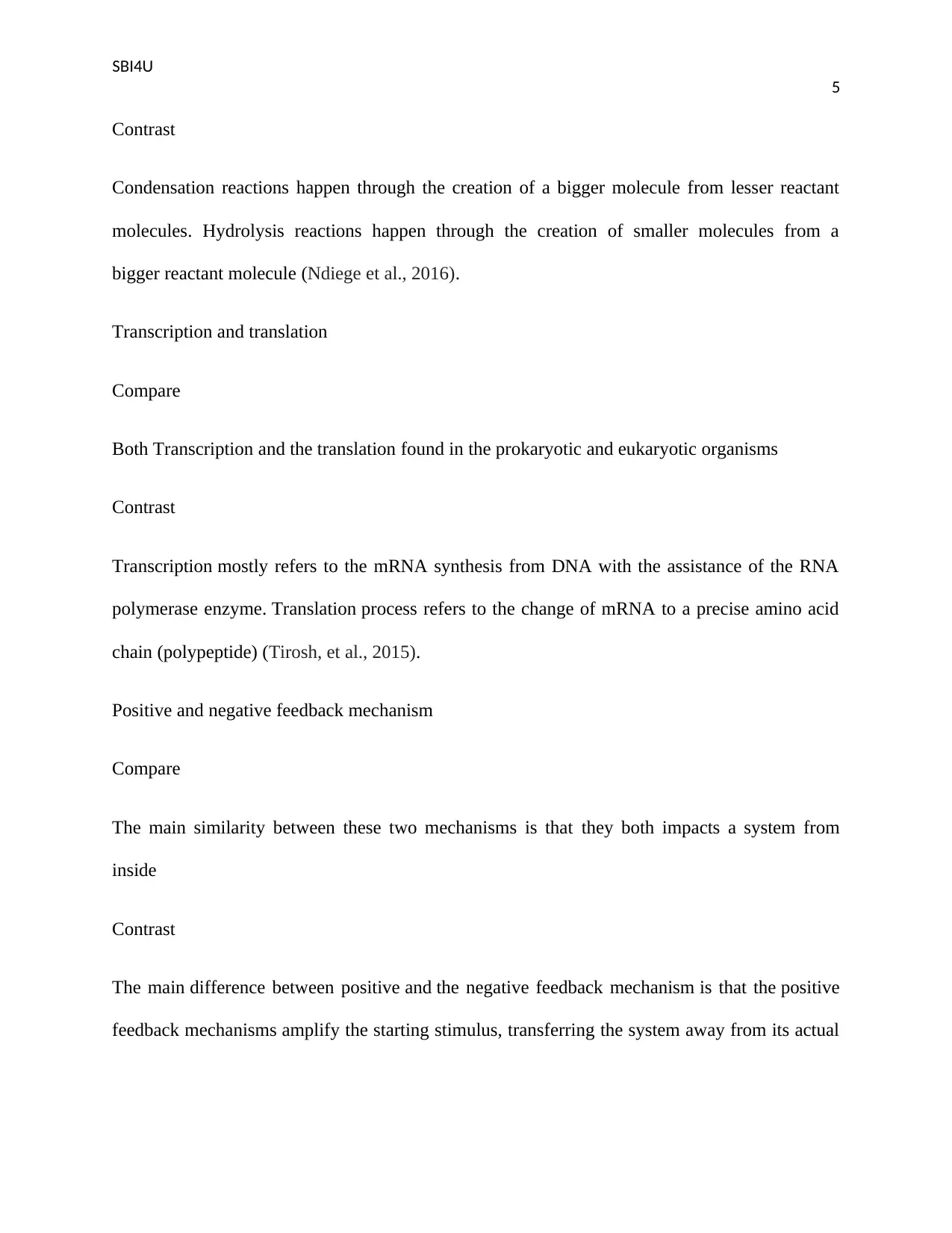
SBI4U
5
Contrast
Condensation reactions happen through the creation of a bigger molecule from lesser reactant
molecules. Hydrolysis reactions happen through the creation of smaller molecules from a
bigger reactant molecule (Ndiege et al., 2016).
Transcription and translation
Compare
Both Transcription and the translation found in the prokaryotic and eukaryotic organisms
Contrast
Transcription mostly refers to the mRNA synthesis from DNA with the assistance of the RNA
polymerase enzyme. Translation process refers to the change of mRNA to a precise amino acid
chain (polypeptide) (Tirosh, et al., 2015).
Positive and negative feedback mechanism
Compare
The main similarity between these two mechanisms is that they both impacts a system from
inside
Contrast
The main difference between positive and the negative feedback mechanism is that the positive
feedback mechanisms amplify the starting stimulus, transferring the system away from its actual
5
Contrast
Condensation reactions happen through the creation of a bigger molecule from lesser reactant
molecules. Hydrolysis reactions happen through the creation of smaller molecules from a
bigger reactant molecule (Ndiege et al., 2016).
Transcription and translation
Compare
Both Transcription and the translation found in the prokaryotic and eukaryotic organisms
Contrast
Transcription mostly refers to the mRNA synthesis from DNA with the assistance of the RNA
polymerase enzyme. Translation process refers to the change of mRNA to a precise amino acid
chain (polypeptide) (Tirosh, et al., 2015).
Positive and negative feedback mechanism
Compare
The main similarity between these two mechanisms is that they both impacts a system from
inside
Contrast
The main difference between positive and the negative feedback mechanism is that the positive
feedback mechanisms amplify the starting stimulus, transferring the system away from its actual
⊘ This is a preview!⊘
Do you want full access?
Subscribe today to unlock all pages.

Trusted by 1+ million students worldwide
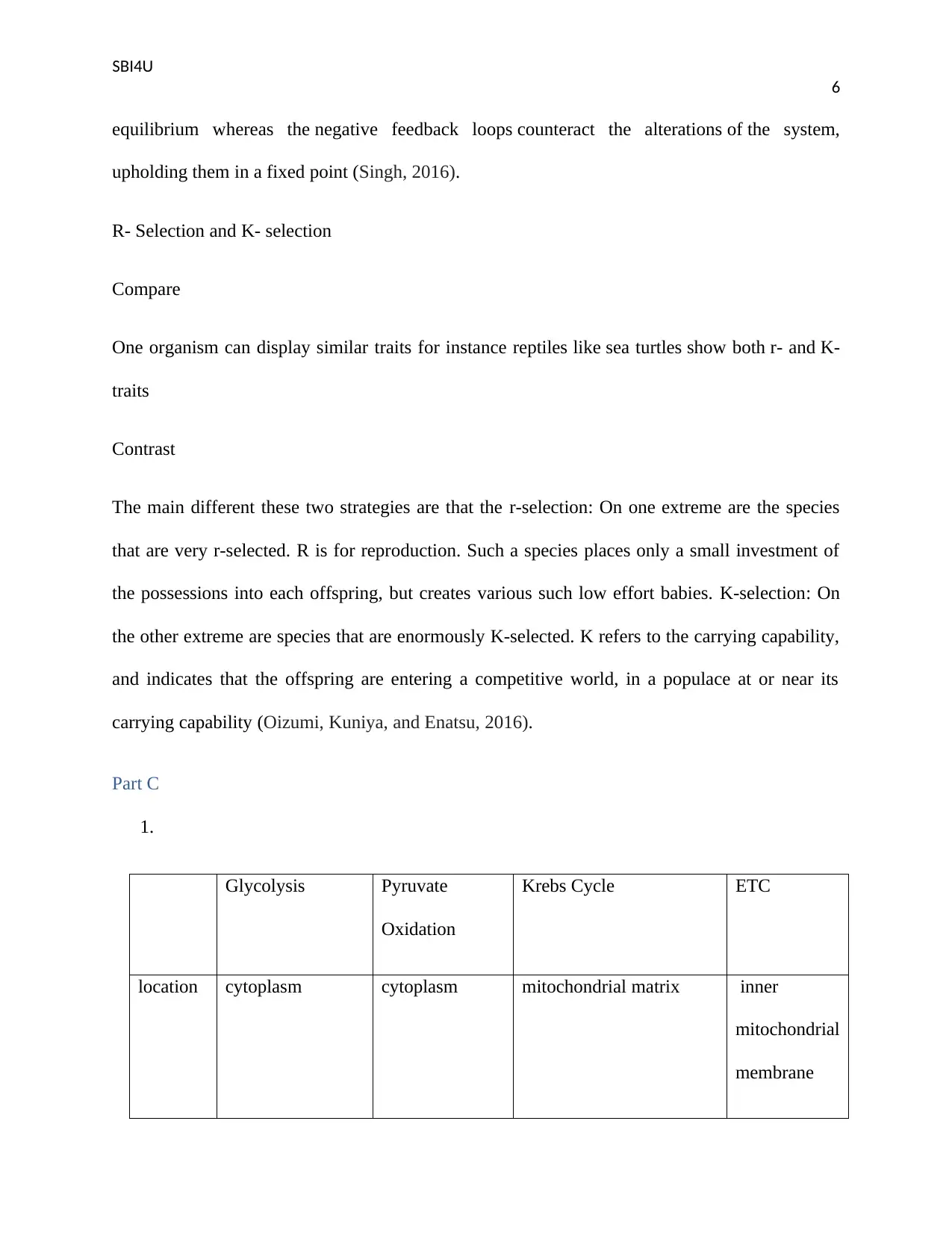
SBI4U
6
equilibrium whereas the negative feedback loops counteract the alterations of the system,
upholding them in a fixed point (Singh, 2016).
R- Selection and K- selection
Compare
One organism can display similar traits for instance reptiles like sea turtles show both r- and K-
traits
Contrast
The main different these two strategies are that the r-selection: On one extreme are the species
that are very r-selected. R is for reproduction. Such a species places only a small investment of
the possessions into each offspring, but creates various such low effort babies. K-selection: On
the other extreme are species that are enormously K-selected. K refers to the carrying capability,
and indicates that the offspring are entering a competitive world, in a populace at or near its
carrying capability (Oizumi, Kuniya, and Enatsu, 2016).
Part C
1.
Glycolysis Pyruvate
Oxidation
Krebs Cycle ETC
location cytoplasm cytoplasm mitochondrial matrix inner
mitochondrial
membrane
6
equilibrium whereas the negative feedback loops counteract the alterations of the system,
upholding them in a fixed point (Singh, 2016).
R- Selection and K- selection
Compare
One organism can display similar traits for instance reptiles like sea turtles show both r- and K-
traits
Contrast
The main different these two strategies are that the r-selection: On one extreme are the species
that are very r-selected. R is for reproduction. Such a species places only a small investment of
the possessions into each offspring, but creates various such low effort babies. K-selection: On
the other extreme are species that are enormously K-selected. K refers to the carrying capability,
and indicates that the offspring are entering a competitive world, in a populace at or near its
carrying capability (Oizumi, Kuniya, and Enatsu, 2016).
Part C
1.
Glycolysis Pyruvate
Oxidation
Krebs Cycle ETC
location cytoplasm cytoplasm mitochondrial matrix inner
mitochondrial
membrane
Paraphrase This Document
Need a fresh take? Get an instant paraphrase of this document with our AI Paraphraser
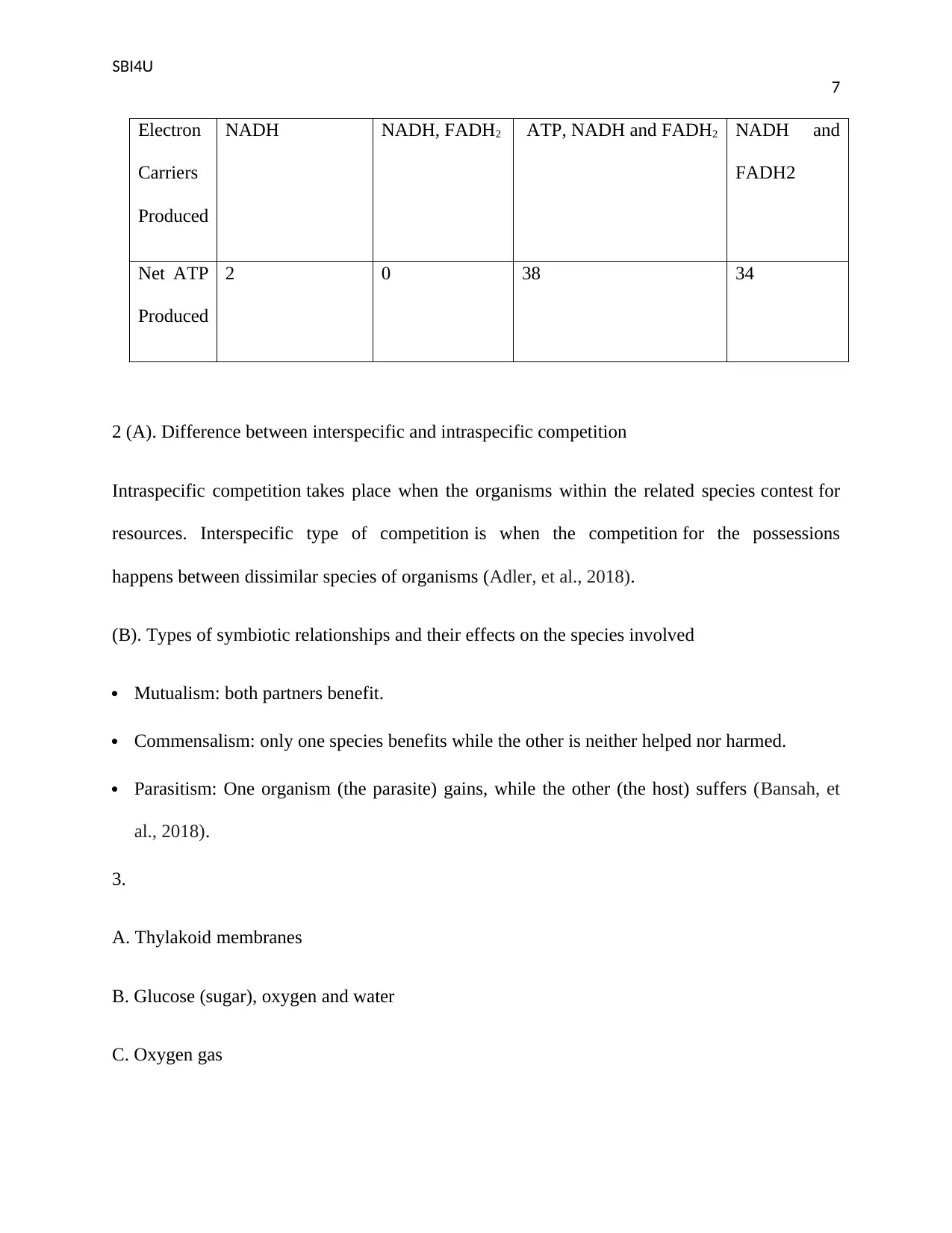
SBI4U
7
Electron
Carriers
Produced
NADH NADH, FADH2 ATP, NADH and FADH2 NADH and
FADH2
Net ATP
Produced
2 0 38 34
2 (A). Difference between interspecific and intraspecific competition
Intraspecific competition takes place when the organisms within the related species contest for
resources. Interspecific type of competition is when the competition for the possessions
happens between dissimilar species of organisms (Adler, et al., 2018).
(B). Types of symbiotic relationships and their effects on the species involved
Mutualism: both partners benefit.
Commensalism: only one species benefits while the other is neither helped nor harmed.
Parasitism: One organism (the parasite) gains, while the other (the host) suffers (Bansah, et
al., 2018).
3.
A. Thylakoid membranes
B. Glucose (sugar), oxygen and water
C. Oxygen gas
7
Electron
Carriers
Produced
NADH NADH, FADH2 ATP, NADH and FADH2 NADH and
FADH2
Net ATP
Produced
2 0 38 34
2 (A). Difference between interspecific and intraspecific competition
Intraspecific competition takes place when the organisms within the related species contest for
resources. Interspecific type of competition is when the competition for the possessions
happens between dissimilar species of organisms (Adler, et al., 2018).
(B). Types of symbiotic relationships and their effects on the species involved
Mutualism: both partners benefit.
Commensalism: only one species benefits while the other is neither helped nor harmed.
Parasitism: One organism (the parasite) gains, while the other (the host) suffers (Bansah, et
al., 2018).
3.
A. Thylakoid membranes
B. Glucose (sugar), oxygen and water
C. Oxygen gas
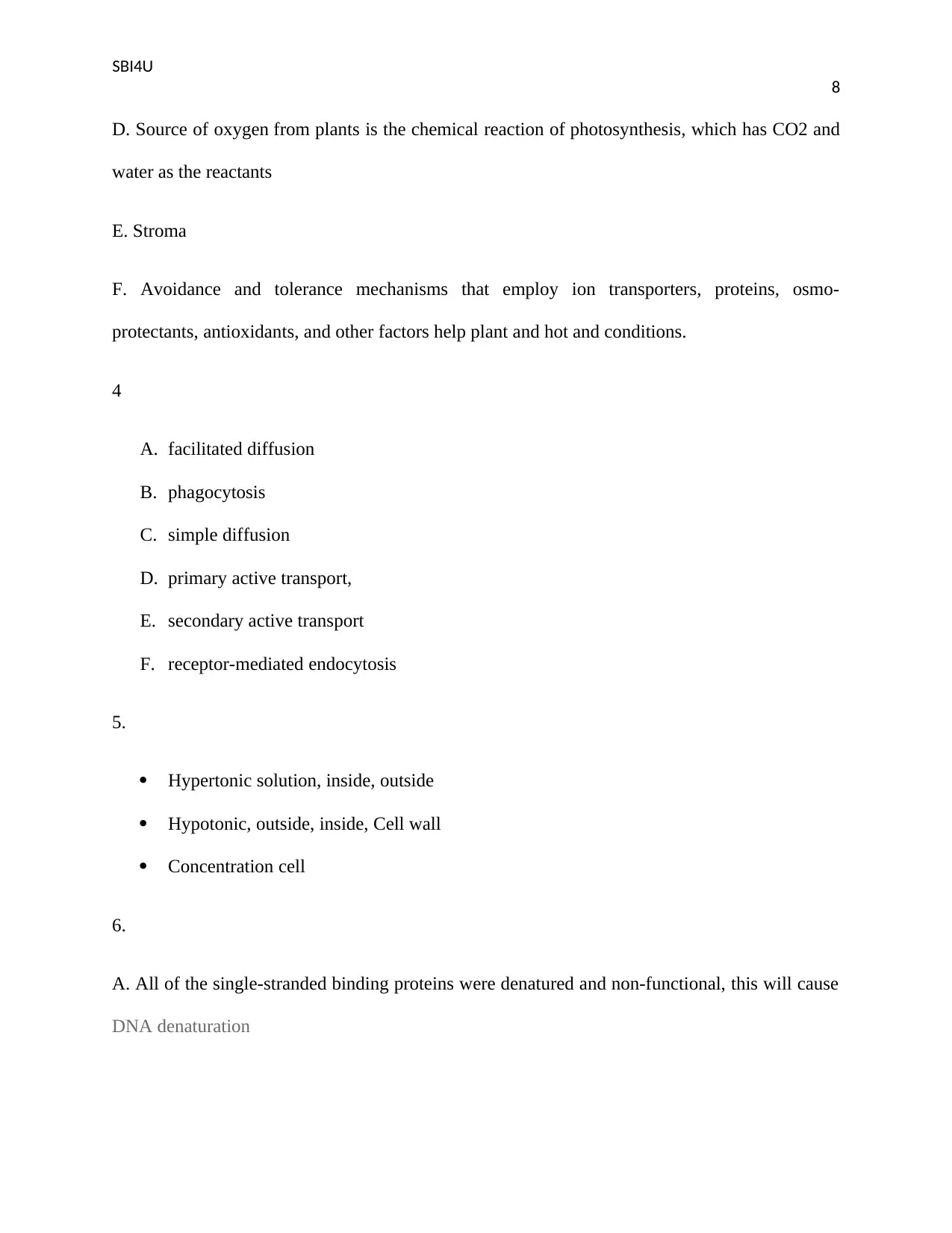
SBI4U
8
D. Source of oxygen from plants is the chemical reaction of photosynthesis, which has CO2 and
water as the reactants
E. Stroma
F. Avoidance and tolerance mechanisms that employ ion transporters, proteins, osmo-
protectants, antioxidants, and other factors help plant and hot and conditions.
4
A. facilitated diffusion
B. phagocytosis
C. simple diffusion
D. primary active transport,
E. secondary active transport
F. receptor-mediated endocytosis
5.
Hypertonic solution, inside, outside
Hypotonic, outside, inside, Cell wall
Concentration cell
6.
A. All of the single-stranded binding proteins were denatured and non-functional, this will cause
DNA denaturation
8
D. Source of oxygen from plants is the chemical reaction of photosynthesis, which has CO2 and
water as the reactants
E. Stroma
F. Avoidance and tolerance mechanisms that employ ion transporters, proteins, osmo-
protectants, antioxidants, and other factors help plant and hot and conditions.
4
A. facilitated diffusion
B. phagocytosis
C. simple diffusion
D. primary active transport,
E. secondary active transport
F. receptor-mediated endocytosis
5.
Hypertonic solution, inside, outside
Hypotonic, outside, inside, Cell wall
Concentration cell
6.
A. All of the single-stranded binding proteins were denatured and non-functional, this will cause
DNA denaturation
⊘ This is a preview!⊘
Do you want full access?
Subscribe today to unlock all pages.

Trusted by 1+ million students worldwide
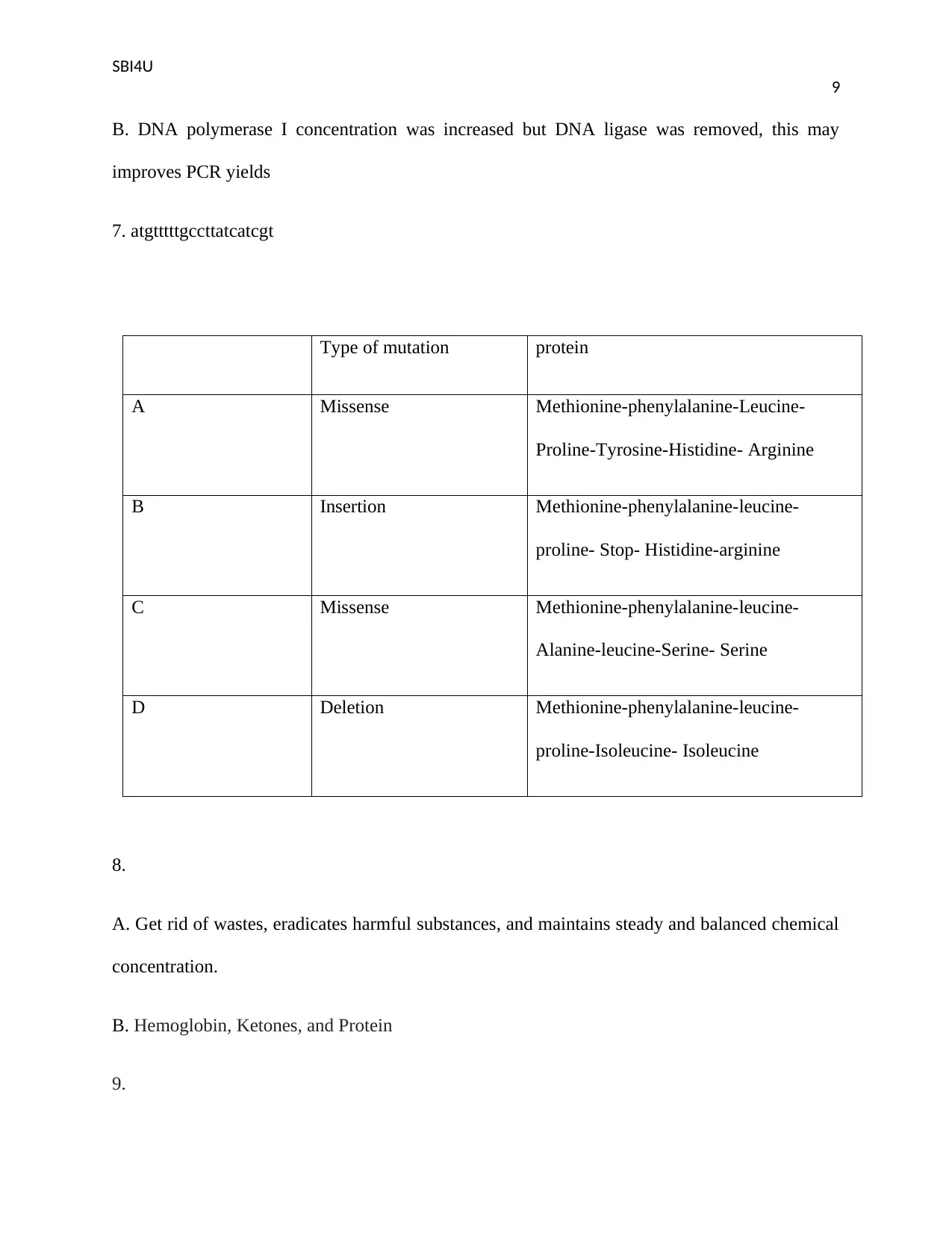
SBI4U
9
B. DNA polymerase I concentration was increased but DNA ligase was removed, this may
improves PCR yields
7. atgtttttgccttatcatcgt
Type of mutation protein
A Missense Methionine-phenylalanine-Leucine-
Proline-Tyrosine-Histidine- Arginine
B Insertion Methionine-phenylalanine-leucine-
proline- Stop- Histidine-arginine
C Missense Methionine-phenylalanine-leucine-
Alanine-leucine-Serine- Serine
D Deletion Methionine-phenylalanine-leucine-
proline-Isoleucine- Isoleucine
8.
A. Get rid of wastes, eradicates harmful substances, and maintains steady and balanced chemical
concentration.
B. Hemoglobin, Ketones, and Protein
9.
9
B. DNA polymerase I concentration was increased but DNA ligase was removed, this may
improves PCR yields
7. atgtttttgccttatcatcgt
Type of mutation protein
A Missense Methionine-phenylalanine-Leucine-
Proline-Tyrosine-Histidine- Arginine
B Insertion Methionine-phenylalanine-leucine-
proline- Stop- Histidine-arginine
C Missense Methionine-phenylalanine-leucine-
Alanine-leucine-Serine- Serine
D Deletion Methionine-phenylalanine-leucine-
proline-Isoleucine- Isoleucine
8.
A. Get rid of wastes, eradicates harmful substances, and maintains steady and balanced chemical
concentration.
B. Hemoglobin, Ketones, and Protein
9.
Paraphrase This Document
Need a fresh take? Get an instant paraphrase of this document with our AI Paraphraser
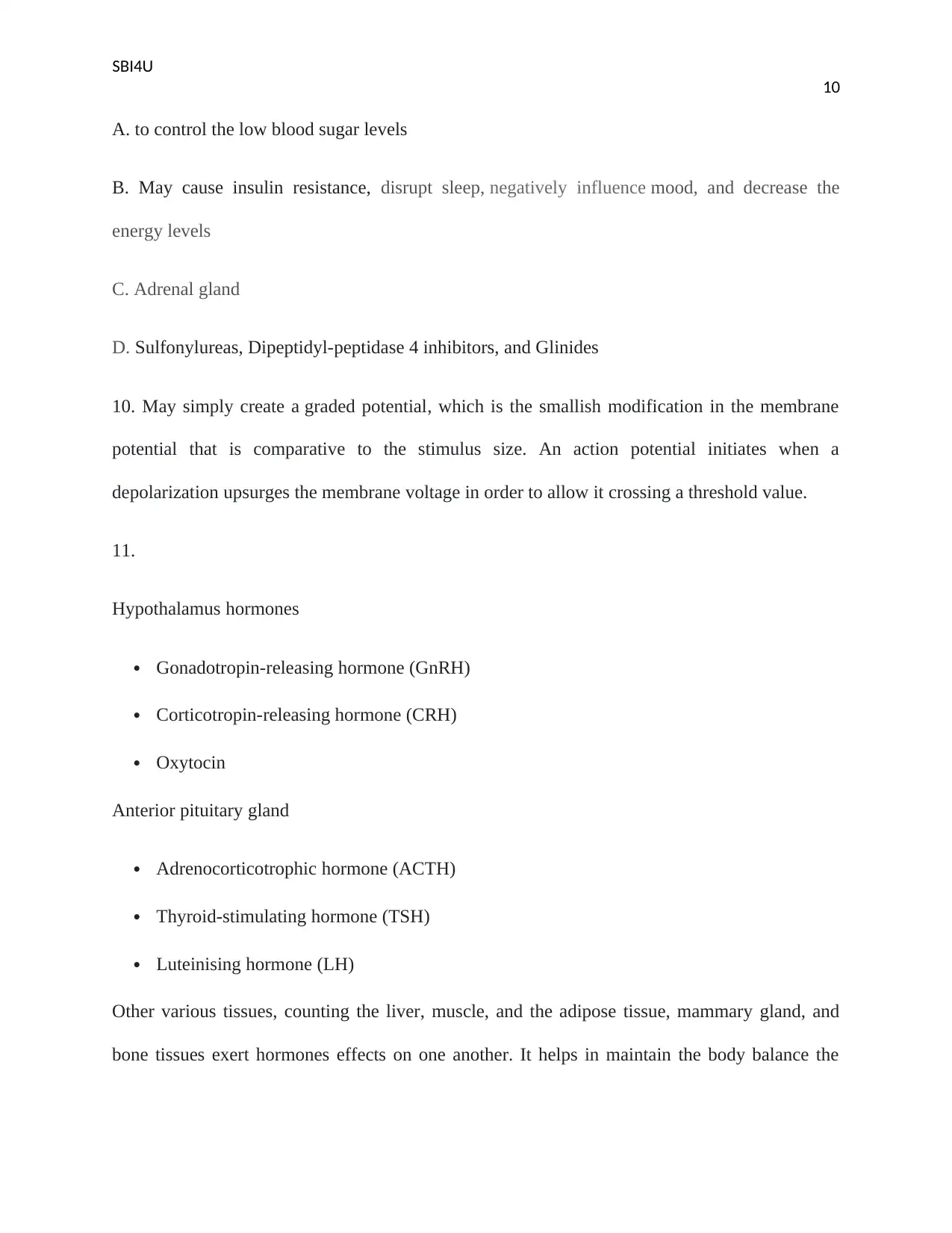
SBI4U
10
A. to control the low blood sugar levels
B. May cause insulin resistance, disrupt sleep, negatively influence mood, and decrease the
energy levels
C. Adrenal gland
D. Sulfonylureas, Dipeptidyl-peptidase 4 inhibitors, and Glinides
10. May simply create a graded potential, which is the smallish modification in the membrane
potential that is comparative to the stimulus size. An action potential initiates when a
depolarization upsurges the membrane voltage in order to allow it crossing a threshold value.
11.
Hypothalamus hormones
Gonadotropin-releasing hormone (GnRH)
Corticotropin-releasing hormone (CRH)
Oxytocin
Anterior pituitary gland
Adrenocorticotrophic hormone (ACTH)
Thyroid-stimulating hormone (TSH)
Luteinising hormone (LH)
Other various tissues, counting the liver, muscle, and the adipose tissue, mammary gland, and
bone tissues exert hormones effects on one another. It helps in maintain the body balance the
10
A. to control the low blood sugar levels
B. May cause insulin resistance, disrupt sleep, negatively influence mood, and decrease the
energy levels
C. Adrenal gland
D. Sulfonylureas, Dipeptidyl-peptidase 4 inhibitors, and Glinides
10. May simply create a graded potential, which is the smallish modification in the membrane
potential that is comparative to the stimulus size. An action potential initiates when a
depolarization upsurges the membrane voltage in order to allow it crossing a threshold value.
11.
Hypothalamus hormones
Gonadotropin-releasing hormone (GnRH)
Corticotropin-releasing hormone (CRH)
Oxytocin
Anterior pituitary gland
Adrenocorticotrophic hormone (ACTH)
Thyroid-stimulating hormone (TSH)
Luteinising hormone (LH)
Other various tissues, counting the liver, muscle, and the adipose tissue, mammary gland, and
bone tissues exert hormones effects on one another. It helps in maintain the body balance the
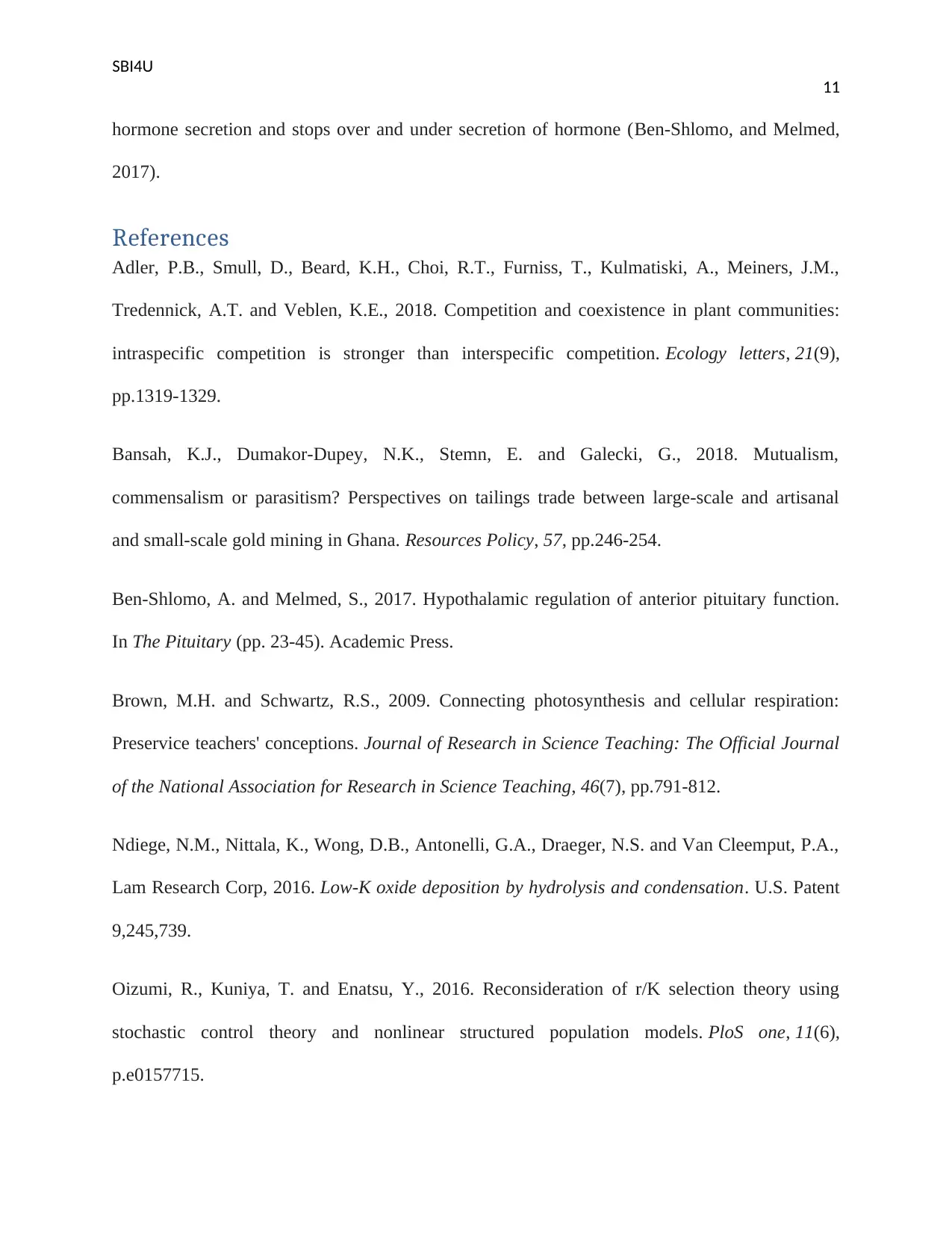
SBI4U
11
hormone secretion and stops over and under secretion of hormone (Ben-Shlomo, and Melmed,
2017).
References
Adler, P.B., Smull, D., Beard, K.H., Choi, R.T., Furniss, T., Kulmatiski, A., Meiners, J.M.,
Tredennick, A.T. and Veblen, K.E., 2018. Competition and coexistence in plant communities:
intraspecific competition is stronger than interspecific competition. Ecology letters, 21(9),
pp.1319-1329.
Bansah, K.J., Dumakor-Dupey, N.K., Stemn, E. and Galecki, G., 2018. Mutualism,
commensalism or parasitism? Perspectives on tailings trade between large-scale and artisanal
and small-scale gold mining in Ghana. Resources Policy, 57, pp.246-254.
Ben-Shlomo, A. and Melmed, S., 2017. Hypothalamic regulation of anterior pituitary function.
In The Pituitary (pp. 23-45). Academic Press.
Brown, M.H. and Schwartz, R.S., 2009. Connecting photosynthesis and cellular respiration:
Preservice teachers' conceptions. Journal of Research in Science Teaching: The Official Journal
of the National Association for Research in Science Teaching, 46(7), pp.791-812.
Ndiege, N.M., Nittala, K., Wong, D.B., Antonelli, G.A., Draeger, N.S. and Van Cleemput, P.A.,
Lam Research Corp, 2016. Low-K oxide deposition by hydrolysis and condensation. U.S. Patent
9,245,739.
Oizumi, R., Kuniya, T. and Enatsu, Y., 2016. Reconsideration of r/K selection theory using
stochastic control theory and nonlinear structured population models. PloS one, 11(6),
p.e0157715.
11
hormone secretion and stops over and under secretion of hormone (Ben-Shlomo, and Melmed,
2017).
References
Adler, P.B., Smull, D., Beard, K.H., Choi, R.T., Furniss, T., Kulmatiski, A., Meiners, J.M.,
Tredennick, A.T. and Veblen, K.E., 2018. Competition and coexistence in plant communities:
intraspecific competition is stronger than interspecific competition. Ecology letters, 21(9),
pp.1319-1329.
Bansah, K.J., Dumakor-Dupey, N.K., Stemn, E. and Galecki, G., 2018. Mutualism,
commensalism or parasitism? Perspectives on tailings trade between large-scale and artisanal
and small-scale gold mining in Ghana. Resources Policy, 57, pp.246-254.
Ben-Shlomo, A. and Melmed, S., 2017. Hypothalamic regulation of anterior pituitary function.
In The Pituitary (pp. 23-45). Academic Press.
Brown, M.H. and Schwartz, R.S., 2009. Connecting photosynthesis and cellular respiration:
Preservice teachers' conceptions. Journal of Research in Science Teaching: The Official Journal
of the National Association for Research in Science Teaching, 46(7), pp.791-812.
Ndiege, N.M., Nittala, K., Wong, D.B., Antonelli, G.A., Draeger, N.S. and Van Cleemput, P.A.,
Lam Research Corp, 2016. Low-K oxide deposition by hydrolysis and condensation. U.S. Patent
9,245,739.
Oizumi, R., Kuniya, T. and Enatsu, Y., 2016. Reconsideration of r/K selection theory using
stochastic control theory and nonlinear structured population models. PloS one, 11(6),
p.e0157715.
⊘ This is a preview!⊘
Do you want full access?
Subscribe today to unlock all pages.

Trusted by 1+ million students worldwide
1 out of 13
Related Documents
Your All-in-One AI-Powered Toolkit for Academic Success.
+13062052269
info@desklib.com
Available 24*7 on WhatsApp / Email
![[object Object]](/_next/static/media/star-bottom.7253800d.svg)
Unlock your academic potential
Copyright © 2020–2025 A2Z Services. All Rights Reserved. Developed and managed by ZUCOL.





